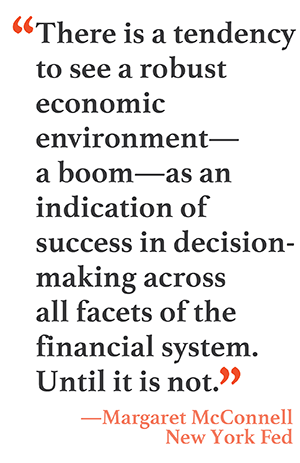 Margaret McConnell often tells Federal Reserve officials that they should be a lot more confused than they let on. That’s her job. She’s head of the Applied Critical Thinking (ACT) unit, a little-known enclave of the New York Fed with a big mandate: to poke holes in the most basic assumptions that central bankers make—assumptions that can lead to big policy mistakes when they’re wrong.
Margaret McConnell often tells Federal Reserve officials that they should be a lot more confused than they let on. That’s her job. She’s head of the Applied Critical Thinking (ACT) unit, a little-known enclave of the New York Fed with a big mandate: to poke holes in the most basic assumptions that central bankers make—assumptions that can lead to big policy mistakes when they’re wrong.
The ACT is there to remind the rest of the institution, whose vast research teams are under constant pressure to supply answers, that doubt is legitimate in the face of complex questions, and that it’s often the things we’re certain about that blow us up. The biggest risks aren’t always out there in the markets, in other words: Sometimes, they’re right inside the building.
“I’m interested in shifting the lens,” McConnell—who rarely appears in public or discusses details of the ACT’s sensitive work—said in an interview last month. “What if what we’re talking about as true, is not true? Looking more for puzzles than for the story you think you know, that’s very hard to do.”
It’s a deliberately unsettling approach, one that matches the mood on the world’s financial markets.
Record highs for all kinds of assets coexist with an uneasy sense that something big could be wrong. Investors are scouring the horizon in search of the next time bomb, whether it’s leveraged loans or the growing pile of negative-yielding debt.
McConnell casts the net wider, to include the policy process itself. The financial crisis offers plenty of illustrations. The Fed got housing markets wrong before the crash, and its estimates of labor resources in the recovery have been off, too. McConnell’s conclusion after 2008 was that economics as practiced at today’s central banks has embedded blind spots.
Her bosses agreed, and that’s how the ACT came to exist. McConnell envisioned a unit that would draw on fields such as psychology, complex systems theory, and design. Former New York Fed President Bill Dudley liked the idea, and McConnell launched it in 2016. There are now about 15 analysts working there.
‘Flair for Darkness’
Dudley calls the financial crisis “a bitter failure of imagination.” Part of that failure happened inside an economics profession more inclined to celebrate its successes.
Fed officials touted the “great moderation” they had engineered. Nobel laureate Robert Lucas argued that the “central problem of depression prevention has been solved.” In August 2008, Olivier Blanchard—about to become the International Monetary Fund’s (IMF’s) chief economist—proclaimed that “the state of macro is good.”
 McConnell is the kind of person who gets worried when everyone else thinks the outlook is bright. She had a “flair for darkness,” Timothy Geithner, the former Treasury secretary and Dudley’s predecessor as New York Fed chief, said in his crisis memoir “Stress Test.” That’s one reason why he chose her to be one of his closest aides.
McConnell is the kind of person who gets worried when everyone else thinks the outlook is bright. She had a “flair for darkness,” Timothy Geithner, the former Treasury secretary and Dudley’s predecessor as New York Fed chief, said in his crisis memoir “Stress Test.” That’s one reason why he chose her to be one of his closest aides.
“She would always ask the awkward question, the uncommon question,” Geithner said in an interview. “She was a famously curious person and deeply skeptical about received wisdom.”
The challenge for the Fed is how to harness that kind of contrarianism into an institution that’s intensely focused on mission-critical daily tasks. As well as setting the world’s most important interest rate, it oversees financial markets, payment systems, and bank balance sheets—all measured in trillions of dollars.
The Fed’s legions of Ph.D. economists are trying to spot the latest trends in trade, investment, prices, or employment so that their bosses can make better policy. Some of the New York Fed’s blog and research posts include topics such as large-bank liquidity needs and how monetary policy announcements impact markets.
The research process is rigorous and hierarchical, former staff members say, with no tolerance for error. They cite an internal saying: You’re not allowed to make the same mistake once.
That’s the culture the ACT is trying to change, according to Dudley. “You can have a regime where people don’t take risks,” he says, but then you’ll miss things, maybe important things. “You can be right in the small. But if you’re not right in the large, it can be a big mistake.”
Changing Fed Tendency to Focus on Congratulations
McConnell, who has a Ph.D. from Ohio State University, joined the Fed’s domestic research team in 1996. A few years later, she began to take an interest in institutional biases—when she brushed up against them herself.
She cowrote a paper about why the volatility of GDP growth was declining and pursued a hunch that just-in-time inventory management had changed things. But inside the Fed, she was encouraged to put more emphasis on the central bank’s newfound ability to stabilize the economy. It was a revealing instance of confirmation bias—the kind, McConnell would later point out, that blinded the Fed to cracks in the financial system before 2008.
“We have this tendency to want to congratulate ourselves,” she said in 2013, in a talk posted on YouTube. “There is a tendency to see a robust economic environment—a boom—as an indication of success in decision-making across all facets of the financial system. Until it is not.”
McConnell has experimented with different ways of getting colleagues to confront worst-case risks. The ACT sometimes runs war games, according to people who’ve taken part. The scenario might be a bank that’s desperate for liquidity but lacks collateral in the U.S., or a Treasury default amid debt-ceiling brinksmanship.
James McAndrews, the New York Fed’s former head of research, recalls one exercise conducted just before an important policy decision. The ACT came up with some fictional news headlines from a year into the future, to illustrate potential outcomes.
“It made us take one step back and think about the lifecycle of an issue,” McAndrews says. The takeaway: “Don’t push too hard along a single line of argument. Because it could be negated.”
McConnell wants to apply insights from other fields—“particularly intelligence, design, climate science, and medicine”—to central banking.
See also:
- Corporate CFOs Are Behaving Defensively
- Emerging Risks: Get Ahead of the Unexpected
- Tips for Maintaining Momentum in an Emerging Risk Program
There are economists on her reading list, like Daniel Kahneman, the Nobel laureate who’s written about the differences between instinctive and logical thinking, and the biases inherent to each. She’s also interested in the work of political scientist Philip Tetlock, the author of “Superforecasting,” and Alex Ryan, a pioneer in complex systems theory at the MaRS innovation hub in Toronto.
Ryan says one lesson from the study of systems is that large-scale collapses aren’t all that rare. He says the ACT’s approach is also employed by armies—which, like other big institutions, are vulnerable to “organizational myths” that become entrenched, especially after successes.
That’s why there’s a so-called Red Team in war games, whose role is to probe and pressure the base case, he says. In a financial scenario, it might be that policymakers can’t see any reason why a particular market should pose risks. “But Red Team will say: ‘Let’s assume that actually this market does collapse, and we get exposed. Let’s figure out what are all the causes that would’ve led to that.’”
McConnell’s ability to keep pushing boundaries may depend on whether Fed leaders believe such exercises are useful.
The Right Answer Is…
Central banks aren’t a natural home for contrarians, said Alberto Musalem, who oversaw the ACT as head of policy analysis at the New York Fed, before leaving to co-found Evince Asset Management. In that respect, they’re a bit different from the financial markets they oversee.
“The incentive structure in the market rewards people who are forward thinkers, lateral thinkers, and who game-play scenarios,” he said. “At the Fed, the incentives aren’t necessarily these.”
For now, McConnell has enthusiastic endorsements from the last three New York Fed presidents. The current one, John Williams, said in a July 12 interview that the ACT has helped to structure analysis and internal debate in new ways. He’s asked the unit to redesign the Fed’s economic briefings, where the traditional format has been to look at evidence and arrive at answers.
“Meg and her team are good at telling us that perhaps that’s not a sign of success,” he said. “Sometimes the right answer is ‘I don’t know.’ We need to keep that in mind.”
© 2025 ALM Global, LLC, All Rights Reserved. Request academic re-use from www.copyright.com. All other uses, submit a request to [email protected]. For more information visit Asset & Logo Licensing.




